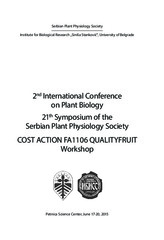Приказ основних података о документу
High PAR and UV-B radiation-induced differential responses in green and white leaf sectors of Pelargonium zonale in relation to sugar, antioxidative and phenolic metabolism
| dc.creator | Vidović, Marija | |
| dc.creator | Morina, Filis | |
| dc.creator | Milić Komić, Sonja | |
| dc.creator | Albert, Andreas | |
| dc.creator | Zechmann, Bernd | |
| dc.creator | Tosti, Tomislav | |
| dc.creator | Winkler, Jana Barbro | |
| dc.creator | Veljović-Jovanović, Sonja | |
| dc.creator | Barbro winkler | |
| dc.date.accessioned | 2023-03-28T06:20:12Z | |
| dc.date.available | 2023-03-28T06:20:12Z | |
| dc.date.issued | 2015 | |
| dc.identifier.isbn | 978-86-912591-3-6 | |
| dc.identifier.uri | http://rimsi.imsi.bg.ac.rs/handle/123456789/1878 | |
| dc.description.abstract | In this study we investigated the specific effects of high photosynthetically active radiation (PAR) and ecologically relevant UV-B radiation (0.90 W m-2) on antioxidative, phenolic and sugar metabolism in variegated Pelargonium zonale plants. The green-white leaf variegation in these plants presents a suitable model system for examining “source-sink” interactions within the same leaf. High PAR (1350 μmol m-2 s-1) and UV-B radiation induced tissue specific responses in variegated P. zonale leaves. While UV-B radiation had a pronounced effect on phenolic content in the white tissue, high PAR intensity stimulated accumulation of phenylpropanoids and flavonoids with preferential antioxidative vs. UV-screening function in green tissue. High PAR stimulated the increase of antioxidative metabolism in both leaf sections. However, the greater enhancement of ascorbate peroxidase and catalase activities and ascorbate content under HL+UV-B than HL only in green sectors, indicated that UV-B radiation and high PAR synergistically stimulated antioxidative defense. These results indicate that green tissue can be considered as high light acclimated, provided with an efficient defense against potential oxidative pressure under high PAR, along with significant protective role of UV-B radiation. Efficient sugar transport from green to white tissue was stimulated by both UV-B radiation and high PAR intensity. By stimulation of starch and sucrose breakdown and carbon allocation in the form of soluble sugars from “source” (green) tissue to “sink” (white) tissue, UV-B radiation stimulates a compensatory mechanism for phenylpropanoid and flavonoid biosynthesis in white tissue, due to the lack of photosynthesis. | sr |
| dc.language.iso | en | sr |
| dc.publisher | Serbian Plant Physiology Society | sr |
| dc.publisher | Institute for Biological Research “Siniša Stanković” – National Institute of Republic of Serbia, University of Belgrade | sr |
| dc.rights | openAccess | sr |
| dc.source | 2nd International Conference on Plant Biology • 21st Symposium of the Serbian Plant Physiology Society • COST ACTION FA1106 QUALITYFRUIT Workshop Petnica Science Center 17-20 june, 2015 | sr |
| dc.subject | high light intensity | sr |
| dc.subject | flavonoids | sr |
| dc.subject | sugar distribution | sr |
| dc.subject | UV-B radiation | sr |
| dc.subject | variegated Pelargonium zonale | sr |
| dc.title | High PAR and UV-B radiation-induced differential responses in green and white leaf sectors of Pelargonium zonale in relation to sugar, antioxidative and phenolic metabolism | sr |
| dc.type | conferenceObject | sr |
| dc.rights.license | ARR | sr |
| dc.citation.spage | 154 | |
| dc.identifier.fulltext | http://rimsi.imsi.bg.ac.rs/bitstream/id/4841/bitstream_4841.pdf | |
| dc.identifier.rcub | https://hdl.handle.net/21.15107/rcub_rimsi_1878 | |
| dc.type.version | publishedVersion | sr |

